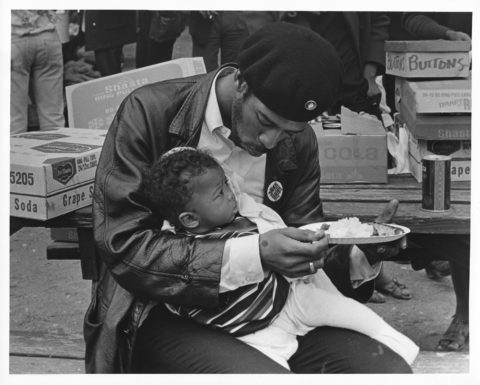Portraying intimate moments to some of the most defiant in California history, the extraordinary photographic archive of husband-and-wife team Pirkle Jones and Ruth-Marion Baruch is a treasure box for scholars, students, historians, photographers, and community members alike.

A member of the Black Panther Party feeds his son at a Free Huey rally in DeFremery Park in Oakland. (Photo by Ruth-Marion Baruch, 1968)
The archive, given to UC Santa Cruz last year, consists of photographs documenting the people, landscape, and politics of California in the mid-20th century, capturing images of the state at a time of tremendous social change.
“The fact that this collection came to the UC Santa Cruz Library and not to a private museum is significant,” said Elisabeth Remak-Honnef, head of Special Collections and Archives. “We are able to provide students and researchers with an unusually rare opportunity to personally engage with the images they wish to see and study.”
Unlike museums, where you can only see materials on exhibit, the entire collection is available to the general public. People may come in and request individual photographs to be looked at in the reading room.
“This very personal experience is quite special in the world of major photography collections,” Remak-Honnef said.
Some of Jones and Baruch’s best-known photographic series include Berryessa Valley (1956), Haight Ashbury (during the Summer of Love, 1967), Black Panthers (1968), and Gate Five in Sausalito (1969–75).
The gift includes more than 12,000 photographic prints, 25,000 negatives, and thousands of transparencies created by the photographers over the course of their careers, as well as a selection of prints by such colleagues and collaborators as Dorothea Lange, Brett and Edward Weston, Ansel Adams, and Minor White.
Above: These photos are from the series Illusion for Sale, San Francisco, by Ruth-Marion Baruch, 1961. With this series, Baruch offers “a clandestine, but sympathetic study of very intimate, yet universally experienced moments of exploring personal identity,” said Mary deVries, the archivist who is processing the collection.
Project archivist Mary deVries is working with student assistants to process the materials and make them easily accessible to researchers.
The work of Jones (1914–2009) and Baruch (1922–97) has been exhibited at museums throughout the country and abroad. The library plans to loan items to the de Young Museum in San Francisco for its upcoming Summer of Love exhibition, and to traveling exhibits in 2018.
“The stories Ruth-Marion and Pirkle captured from the 1940s through the 1970s are just as relevant today as when they were created—our society is grappling with the same social, political, racial, and environmental issues,” said Remak-Honnef. “Students and researchers are eager to engage with these issues, and appreciation for such beautiful photographs is timeless.”












